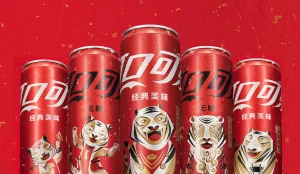In an era where consumers are prioritising personalisation, cultural relevance and sustainability, localised packaging can be an astute way to make your brand stand out and attract customers. This goes beyond language translation and involves tailoring your product’s packaging to resonate with your audience’s preferences and cultural nuances. Read on to learn more about the most effective ways to localise packaging for your customers.
The buying and unboxing experience
Imagine you’ve ordered a new watch or expensive piece of jewellery. You’ve been saving up to buy it and finally been able to make the purchase, so you’re feeling excited about getting your parcel and seeing what’s inside. It arrives, but it’s in a cardboard box that looks like the packaging you might get from an Amazon order. How would you react?
Most likely, you’d be disappointed. If you purchase something you deem a luxury item or that’s special to you, you want the excitement and anticipation of opening it. It shows effort and care on the part of the seller, and it creates a positive unboxing experience for the buyer. That’s why we wrap gifts for Christmas and birthdays, after all.
The quality of the unboxing experience, which could be the first time the buyer sees their purchase first-hand, can have an impact on whether they return to your brand. How? Well, packaging communicates a brand’s image, values and messaging. It helps build excitement and suspense, leading to a better overall experience for the customer. For example, a perfume product will benefit from using packaging that appears more luxurious and feels personalised to the customer when they open the package, whether that’s through an ornate design, a handwritten note or a reusable box.
Of course, while not all products require extravagant packaging, they do all require thoughtful packaging. If you have an eco-friendly audience, for example, it will be essential to use sustainable packaging and communicate this clearly to the buyer. If your customers are buying your product as a treat or gift, it’s important to use packaging that makes them feel special. If your product is more of a necessity for your customers, make sure it’s packaged carefully so that it arrives undamaged and is easy to open.
A positive buying and unboxing experience for your customer not only means potentially gaining a repeat customer, but also, nowadays, both positive and negative reviews spread quickly through social media. In other words, putting thought and attention into how you package your product could make all the difference in improving product sales.
Cultural differences in packaging
When it comes to packaging, cultural differences can be found in the most unexpected places. For example, milk is sold in plastic bags in some parts of Canada, while you can typically find it in cartons or plastic bottles in the US and much of Europe. You may not think that this constitutes a big cultural difference, but a dairy company looking to enter the Canadian market might want to evaluate their packaging to make sure their product matches what people are used to seeing or buying.
A Dutch company called Neerlandia learned this the hard way. Initially, it had sold its powdered milk in African countries in tin cans but decided to switch to aluminium foil pouches instead. Local customers did not want to buy the product anymore because they were used to repurposing the cans for other uses, such as storing things and boiling water.
Examples like Neerlandia prove the importance of doing market research prior to entering a new market. It’s essential to learn the cultural habits of customers that could impact your product prior to trying to sell it to them. What’s more, different colours, images and symbols carry different meanings depending on the country and you don’t want to harm your product sales because you didn’t do your research beforehand.
Conducting market research ahead of time also means you have the knowledge to develop new ideas that are unique to a particular audience. For example, using seasonal packaging or localised packaging that celebrates certain regional holidays can be very effective in building a positive relationship with a new audience of customers. This can be accomplished through extensive market research that includes surveying consumers themselves and collaborating with local artists and designers.
 Consider Coca-Cola’s campaigns for Lunar New Year, which run across multiple Asian countries, including China, Japan, South Korea, Singapore, Malaysia and Cambodia. They typically feature the Chinese zodiac animal of the coming year; for example, 2022 was the Year of the Tiger, so this was a central theme in Coca-Cola’s packaging. Other themes include family, food and traditional elements, such as red decorations and banners, which can also be seen in the packaging design for 2022.
Consider Coca-Cola’s campaigns for Lunar New Year, which run across multiple Asian countries, including China, Japan, South Korea, Singapore, Malaysia and Cambodia. They typically feature the Chinese zodiac animal of the coming year; for example, 2022 was the Year of the Tiger, so this was a central theme in Coca-Cola’s packaging. Other themes include family, food and traditional elements, such as red decorations and banners, which can also be seen in the packaging design for 2022.
Creating localised packaging
What does the localisation of packaging entail? First of all, there is the adaptation of the product itself to better adhere to local regulations or to suit local market preferences. This first step is based on market research, which should be done prior to starting localisation to ensure a focused and smooth process.
Then linguistic and cultural elements must be adapted through translation to fit the target language and culture. This also ensures regulatory compliance in many instances because regulatory bodies typically require information on packaging to be translated into the local language(s). Content translated for packaging often includes product names, product descriptions, nutritional information, amount/size of the product, manufacturing location and date, composition, lists of ingredients (including allergens) and safety measures.
For each type of content, there are specific challenges for the translator to overcome. Product descriptions, for example, are what could convince a customer to buy your product, as they provide information that isn’t given in the image, design or product name. They might also highlight specific traits of the product that appeal to your audience (e.g. gluten-free or vegan), and this needs to be accurately localised.
Ingredient lists may seem like a more straightforward type of content to translate, but this is where regulations come into play. In some countries, certain ingredients must be referred to by their common name, while in others, they are assigned a number and listed as such on the label. Additionally, this part of the label frequently includes key information, such as allergens, which makes accuracy and rigorous quality checks of prime importance.
Moreover, there are marketing elements that must be accurately translated, such as a brand name or a slogan, as these can have a particularly big impact on the buyer and, in turn, on sales of the product in a new market. For example, when Coca-Cola entered the Chinese market back in the 1920s, their first attempt at a direct transliteration of the brand meant “biting the wax tadpole” in Chinese. Unsurprisingly, this was not a very successful launch and they had to change it to the current name, which is phonetically very close to “Coca-Cola” and means “tasty fun”, a far cry from the original translation blunder.
A big challenge in creating localised packaging is the adaptation of graphics and design, which is done for a number of reasons. A redesign may be necessary to avoid cultural misunderstandings associated with a certain symbol or colour. On the other hand, this could be done simply out of necessity, perhaps because local packaging regulations require certain information to be moved to the front of a package.
When a graphics-heavy sector like packaging needs translation services, a process called DTP (desktop publishing) is often done to check layout and design as it relates to the functionality and readability of the translated text. Then, at the end of the translation process, a QA (quality assurance) check is run to make sure that the linguistic, cultural and layout elements are accurate, consistent and relevant for the target market.
Finally, an essential piece of the puzzle when it comes to localised packaging is requesting feedback from customers, as this can help pinpoint areas for improvement or adjustment. Ultimately, you want your product to resonate with customers. The best way to know if it does is to ask them, so following up with surveys or focus groups can be very useful.
EU compliance through localisation
If you are looking to enter the EU market, you will need to ensure that your packaging adheres to EU regulations. This means that all product labelling, including packaging, must be translated into the official languages of the countries in which the product is sold. This can vary depending on the country; for example, Switzerland has four official languages and packaging must include three of them: German, French and Italian.
Localised packaging must also accurately communicate all required information, including product ingredients, usage instructions, warnings and regulatory statements. Some EU regulations also specify the format, size and placement of certain labelling elements, such as ingredient lists and allergen warnings. By properly localising your packaging, you ensure that consumers across the EU can access essential product information in their native languages, promoting safety and consumer rights.
In the EU, there are also certain industries that are subject to specific directives and regulations, such as food, cosmetics and medical devices. In the translation and localisation process, it’s essential to know how these regulations differ between markets and understand the changes that must be made to comply with them.
Green packaging and sustainability
Sustainability is a key issue when it comes to packaging. According to a 2023 study, 82% of consumers are willing to pay more for sustainable packaging and 71% had chosen a product in the last six months based on its sustainability credentials. Eco-friendliness is at the front of consumers’ minds, and it should be a top priority for any company that packages and sells products.
Not only does more sustainable packaging significantly reduce your impact on the environment, but it is also a clear way to communicate to consumers that your company is environmentally conscious. However, the same study found that 59% of consumers search for sustainability information on the label before they make a buying decision, while 46% say that the biggest barrier to making a purchase is unclear labelling on the package.
Localisation must be a key part of your transition to green packaging because clear communication with your customers in their native language could convince them to choose your product over that of your competitor. If you’ve invested in greener packaging for its environmental benefits, why miss out on connecting with like-minded customers because you can’t communicate with them?
In an interconnected world, successful businesses understand the importance of localisation in product packaging. Not only does it help you resonate with consumers and build brand longevity, but you can also communicate your commitment to cultural appreciation and global sustainability. As people look for increasingly personalised content from brands, localised packaging is what can help you stand out.
For more on our packaging localisation solutions, click here.



